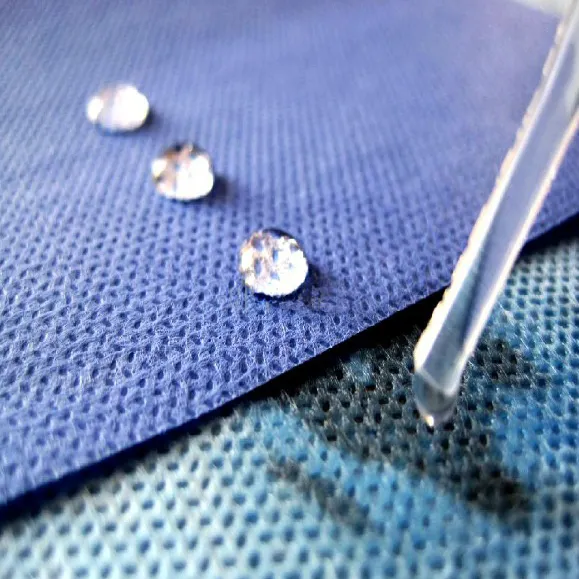The Chemistry of Quality: Diving Deeper into Fiber Selection
Examining the fiber selection’s role in determining the quality of SMS nonwoven fabric gives us a deeper appreciation of the intricate chemistry involved. High-quality fibers ensure that the Spunbond and Meltblown layers’ intended properties are not compromised.
In the Spunbond layers, the fibers need to possess excellent tensile strength to bestow the fabric with durability and resistance to wear and tear. This strength is achieved by using synthetic fibers such as polypropylene or polyester, which have high tensile properties. Additionally, these fibers also contribute to the fabric’s softness, a characteristic that enhances comfort in applications such as medical apparel and personal hygiene products.
The Meltblown layer, on the other hand, requires fibers with a high surface area to volume ratio to achieve optimal barrier properties. As the Meltblown layer’s primary function is to act as a barrier, the fibers must be capable of trapping microscopic particles effectively. Fibers with a smaller diameter have a higher surface area, enabling efficient entrapment of particles and liquids. Thus, high-quality fibers for the Meltblown layer typically have a small diameter and are also made from synthetic materials like polypropylene due to their superior melt properties.
A Balancing Act: Process Precision and Quality Assurance
While the selection of high-quality fibers lays the foundation for a quality SMS nonwoven fabric, the importance of precision in the production process and stringent quality control measures cannot be overlooked. The production process of SMS fabric involves an intricate sequence of steps, each of which requires careful control to ensure the quality of the final product.
During Spunbonding and Meltblowing, controlling the temperature and airflow is critical to achieve the desired fiber properties. For instance, too high a temperature may damage the fibers, reducing their strength, while too low a temperature may result in incomplete melting, affecting the fiber distribution in the Meltblown layer.
The collection process also plays a crucial role in determining the fabric’s quality. It must be carefully controlled to ensure a uniform fiber distribution, affecting the fabric’s overall strength, barrier properties, and appearance. An uneven distribution can create weak spots in the fabric, compromising its performance in applications where consistent strength and barrier properties are crucial.
The role of rigorous quality control measures in ensuring the quality of SMS fabric is a key part of this quality-performance puzzle. Quality control activities such as visual inspections, mechanical testing, and barrier performance tests allow manufacturers to verify the fabric’s quality. These measures allow for the identification and rectification of quality issues before the fabric is utilized in product manufacturing, thereby ensuring optimal performance.
The Sustainability Link: Quality and Environmental Impact
As conversations around sustainability continue to gain momentum, the link between the quality of SMS nonwoven fabric and its environmental impact becomes increasingly relevant. High-quality fabrics result in less waste during production, improved product lifespan, and a reduced need for frequent replacements. These factors significantly influence the fabric’s overall environmental footprint.
High-quality SMS nonwoven fabric is more likely to be durable and have a longer useful life. This durability reduces the need for frequent replacement, thereby saving resources. Additionally, a longer product lifespan means less waste is generated, contributing to sustainability.
Furthermore, the production of high-quality SMS fabric often involves the efficient use of resources, minimizing waste generation. Manufacturing processes that prioritize quality tend to be more precise and controlled, leading to efficient material usage and reduced waste generation.
Quality Beyond the Surface: Impact on End User
Understanding the impact of SMS nonwoven fabric quality on the end-user experience allows us to perceive the quality-performance correlation from a broader perspective. Regardless of whether the fabric is being used in a surgical gown, a filtration system, or a personal hygiene product, its quality will ultimately affect the user’s experience with the final product.
High-quality SMS fabric results in final products that are reliable and efficient. For instance, in medical applications, a high-quality fabric translates into effective barrier protection, ensuring the safety of healthcare professionals. In filtration applications, it results in efficient particle entrapment, leading to clean, safe environments. In personal hygiene products, it provides comfort and superior fluid management, enhancing user experience.
Customer satisfaction, therefore, is directly linked to the quality of SMS nonwoven fabric. As customers become more discerning and quality-conscious, the focus on fabric quality becomes even more critical.
Looking Ahead: Quality as the Guiding Principle
In conclusion, quality in the context of SMS nonwoven fabric is not merely a measure of good vs. bad. It is a multidimensional aspect that influences the fabric’s performance across various parameters, impacting the end-user experience and even the fabric’s environmental footprint.
The role of quality as the guiding principle in the manufacturing and application of SMS nonwoven fabric is clear. As we advance in our understanding and technology, the pursuit of quality will continue to drive innovation in the nonwoven fabric industry. By focusing on quality, manufacturers can not only enhance product performance but also contribute to sustainability and improve user satisfaction.
Indeed, as we continue to explore and innovate within the fascinating realm of SMS nonwoven fabric, one thing remains clear – the quest for quality is integral to achieving superior performance, ensuring user satisfaction, and paving the way for a sustainable future. As we unravel the intricacies of SMS nonwoven fabric, we realize that the journey is not just about understanding the fabric, but about appreciating the profound impact of quality on every aspect of its existence and application.

